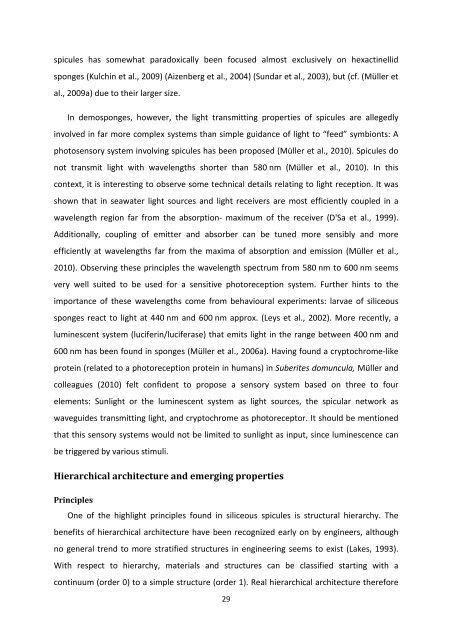MASTER THESIS Biomimetic potential of sponge ... - IAP/TU Wien
MASTER THESIS Biomimetic potential of sponge ... - IAP/TU Wien
MASTER THESIS Biomimetic potential of sponge ... - IAP/TU Wien
Create successful ePaper yourself
Turn your PDF publications into a flip-book with our unique Google optimized e-Paper software.
spicules has somewhat paradoxically been focused almost exclusively on hexactinellid<br />
<strong>sponge</strong>s (Kulchin et al., 2009) (Aizenberg et al., 2004) (Sundar et al., 2003), but (cf. (Müller et<br />
al., 2009a) due to their larger size.<br />
In demo<strong>sponge</strong>s, however, the light transmitting properties <strong>of</strong> spicules are allegedly<br />
involved in far more complex systems than simple guidance <strong>of</strong> light to “feed” symbionts: A<br />
photosensory system involving spicules has been proposed (Müller et al., 2010). Spicules do<br />
not transmit light with wavelengths shorter than 580 nm (Müller et al., 2010). In this<br />
context, it is interesting to observe some technical details relating to light reception. It was<br />
shown that in seawater light sources and light receivers are most efficiently coupled in a<br />
wavelength region far from the absorption- maximum <strong>of</strong> the receiver (D'Sa et al., 1999).<br />
Additionally, coupling <strong>of</strong> emitter and absorber can be tuned more sensibly and more<br />
efficiently at wavelengths far from the maxima <strong>of</strong> absorption and emission (Müller et al.,<br />
2010). Observing these principles the wavelength spectrum from 580 nm to 600 nm seems<br />
very well suited to be used for a sensitive photoreception system. Further hints to the<br />
importance <strong>of</strong> these wavelengths come from behavioural experiments: larvae <strong>of</strong> siliceous<br />
<strong>sponge</strong>s react to light at 440 nm and 600 nm approx. (Leys et al., 2002). More recently, a<br />
luminescent system (luciferin/luciferase) that emits light in the range between 400 nm and<br />
600 nm has been found in <strong>sponge</strong>s (Müller et al., 2006a). Having found a cryptochrome-like<br />
protein (related to a photoreception protein in humans) in Suberites domuncula, Müller and<br />
colleagues (2010) felt confident to propose a sensory system based on three to four<br />
elements: Sunlight or the luminescent system as light sources, the spicular network as<br />
waveguides transmitting light, and cryptochrome as photoreceptor. It should be mentioned<br />
that this sensory systems would not be limited to sunlight as input, since luminescence can<br />
be triggered by various stimuli.<br />
Hierarchical architecture and emerging properties<br />
Principles<br />
One <strong>of</strong> the highlight principles found in siliceous spicules is structural hierarchy. The<br />
benefits <strong>of</strong> hierarchical architecture have been recognized early on by engineers, although<br />
no general trend to more stratified structures in engineering seems to exist (Lakes, 1993).<br />
With respect to hierarchy, materials and structures can be classified starting with a<br />
continuum (order 0) to a simple structure (order 1). Real hierarchical architecture therefore<br />
29

















